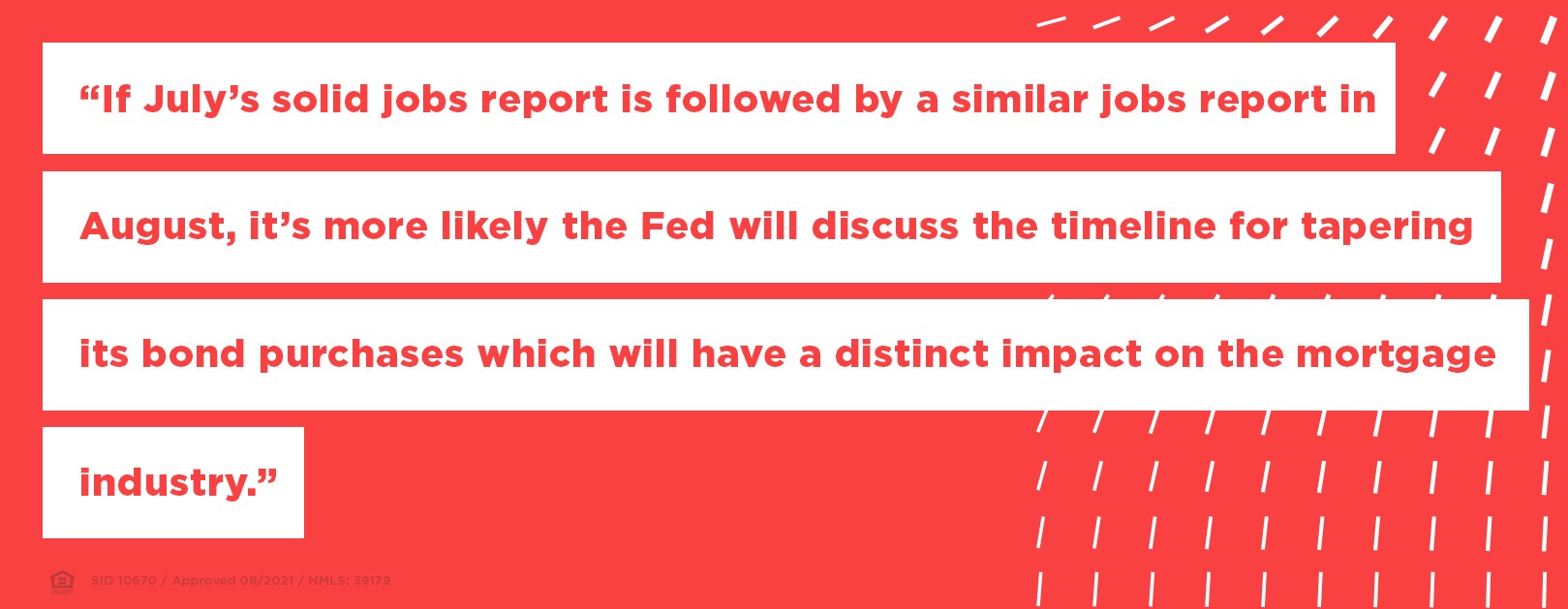Markets prepare for tapering from Federal Reserve
The stock market took a hit this week as investors continue to digest the effects of the spread of the COVID-19 Delta variant as well as the idea that the Federal Reserve will start to taper its bond purchases potentially as early as September.

The Fed started buying $120 billion worth of Treasury and mortgage bonds per month at the onset of the COVID-19 pandemic. This, along with reducing the overnight lending rate to 0%, has helped keep mortgage interest rates at historic lows. The Fed has been staunch in its view of continuing bond buying at this level and holding interest rates at 0% until the economy recently showed consistent signs of strengthening. If July's solid jobs report is followed by a similar jobs report in August, it's more likely the Fed will discuss the timeline for tapering its bond purchases which will have a distinct impact on the mortgage industry.
Rates stayed mostly flat this past week as the Freddie Mac average on a 30-year fixed-rate mortgage held at 2.86%. Any tick upward in rates has proven to slow down mortgage applications from potential homebuyers. The Mortgage Bankers Association's latest data shows refinance applications dropped by 5% week-over-week with purchase applications falling by 1% on a weekly basis. On an annual basis, mortgage purchase applications fell by 19%.
As Freddie Mac's data notes, "there is strong latent demand" for homes but "low supply has caused prices to rise as shortages restrict the amount of sales activity that otherwise would occur." The rise in prices is due in large part to a lack of inventory which has been compounded by supply chain shortages making construction difficult.
The National Association of Homebuilders/Wells Fargo Housing Market Index dropped by 5 points in August down to 75 points. Anything above 50 is considered positive, but this is a fairly distinct dropoff from the 78 point reading we saw a year ago. The price of lumber has come down significantly but other materials like drywall and flooring are also proving to be scarce. Not to mention, labor continues to be the biggest obstacle for many builders as noted in the NAHB report.
It is interesting to note that new home construction reached its highest level in 14 years according to the latest data from the Census Bureau. More than 689,000 single-family homes were under construction in July—the highest number since July 2007. That number can be slightly misleading, however, because it counts all new homes under construction regardless of start date.
Considering that new home starts were down by 7% in July, it's more likely that it's just taking a longer amount of time for homes to be completed due to the issues noted in the homebuilder sentiment index.
Paying rent on time? Yep, it counts
A recent ruling by the Federal Housing Finance Authority says that paying your rent on time will be accounted for in your Fannie Mae mortgage underwriting. Furthermore, missed rental payments will not count against potential homebuyers.
FHFA acting director Sandra Thompson said, "For many households, rent is the single largest monthly expense. There is absolutely no reason timely payment of monthly housing expenses shouldn't be included in underwriting calculations." Thompson continued, "With this update, Fannie Mae is taking another step toward understanding how rental payments can more broadly be included in a credit assessment, providing an additional opportunity for renters to achieve the dream of sustainable homeownership."


